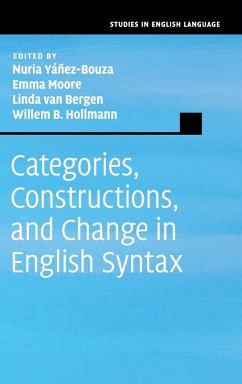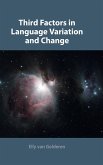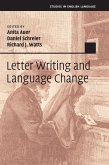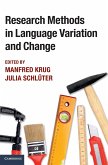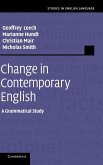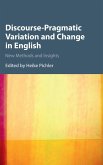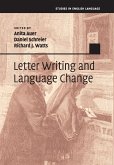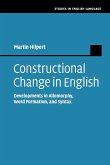Categories, Constructions, and Change in English Syntax
Herausgeber: Yáñez-Bouza, Nuria; Bergen, Linda van; Moore, Emma
Categories, Constructions, and Change in English Syntax
Herausgeber: Yáñez-Bouza, Nuria; Bergen, Linda van; Moore, Emma
- Gebundenes Buch
- Merkliste
- Auf die Merkliste
- Bewerten Bewerten
- Teilen
- Produkt teilen
- Produkterinnerung
- Produkterinnerung
Explores categories, constructions, and change in the syntax of English, both past and present, methodologically and theoretically.
Andere Kunden interessierten sich auch für
![Third Factors in Language Variation and Change Third Factors in Language Variation and Change]() Elly Van GelderenThird Factors in Language Variation and Change109,99 €
Elly Van GelderenThird Factors in Language Variation and Change109,99 €![Letter Writing and Language Change Letter Writing and Language Change]() Letter Writing and Language Change114,99 €
Letter Writing and Language Change114,99 €![Research Methods in Language Variation and Change Research Methods in Language Variation and Change]() Research Methods in Language Variation and Change129,99 €
Research Methods in Language Variation and Change129,99 €![Change in Contemporary English Change in Contemporary English]() Geoffrey LeechChange in Contemporary English140,99 €
Geoffrey LeechChange in Contemporary English140,99 €![Discourse-Pragmatic Variation and Change in English Discourse-Pragmatic Variation and Change in English]() Discourse-Pragmatic Variation and Change in English126,99 €
Discourse-Pragmatic Variation and Change in English126,99 €![Letter Writing and Language Change Letter Writing and Language Change]() Letter Writing and Language Change37,99 €
Letter Writing and Language Change37,99 €![Constructional Change in English Constructional Change in English]() Martin HilpertConstructional Change in English46,99 €
Martin HilpertConstructional Change in English46,99 €-
-
-
Explores categories, constructions, and change in the syntax of English, both past and present, methodologically and theoretically.
Hinweis: Dieser Artikel kann nur an eine deutsche Lieferadresse ausgeliefert werden.
Hinweis: Dieser Artikel kann nur an eine deutsche Lieferadresse ausgeliefert werden.
Produktdetails
- Produktdetails
- Verlag: Cambridge University Press
- Seitenzahl: 424
- Erscheinungstermin: 10. Oktober 2019
- Englisch
- Abmessung: 235mm x 157mm x 27mm
- Gewicht: 762g
- ISBN-13: 9781108419567
- ISBN-10: 1108419569
- Artikelnr.: 54801394
- Herstellerkennzeichnung
- Libri GmbH
- Europaallee 1
- 36244 Bad Hersfeld
- gpsr@libri.de
- Verlag: Cambridge University Press
- Seitenzahl: 424
- Erscheinungstermin: 10. Oktober 2019
- Englisch
- Abmessung: 235mm x 157mm x 27mm
- Gewicht: 762g
- ISBN-13: 9781108419567
- ISBN-10: 1108419569
- Artikelnr.: 54801394
- Herstellerkennzeichnung
- Libri GmbH
- Europaallee 1
- 36244 Bad Hersfeld
- gpsr@libri.de
Introduction: analysing English syntax past and present Nuria Yáñez-Bouza,
Emma Moore, Linda van Bergen and Willem B. Hollmann; Part I. Approaches to
Grammatical Categories and Categorial Change: 1. What is special about
pronouns? John Payne; 2. What for? Bas Aarts; 3. Whatever happened to
'whatever'? Dan Mccolm and Graeme Trousdale; 4. Are comparative modals
converging or diverging in English? Different answers from the perspectives
of grammaticalisation and constructionalisation Elizabeth Closs Traugott;
5. The definite article in Old English: evidence from Ælfric's Grammar
Cynthia L. Allen; Part II. Approaches to Constructions and Constructional
Change: 6. How patterns spread: the to-infinitival complement as a case of
diffusional change, or 'To-infinitives, and beyond!' Bettelou Los; 7. 'Me
Liketh/Lotheth' but 'I Loue/Hate': impersonal/non-impersonal boundaries in
old and Middle English Ayumi Miura; 8. 'That's luck, if you ask me': the
rise of an intersubjective comment clause Laurel J. Brinton; 9. Misreading
and language change: a foray into qualitative historical linguistics Sylvia
Adamson; 10. The conjunction and in phrasal and clausal structures in the
Old Bailey Corpus Merja Kytö and Erik Smitterberg; Part III. Comparative
and Typological Approaches: 11. The role played by analogy in processes of
language change: the case of English have-to compared to Spanish tener-que
Olga Fischer and Hella Olbertz; 12. Modelling step change: the history of
will-verbs in Germanic Kersti Börjars and Nigel Vincent; 13. Possessives
world-wide: genitive variation in varieties of English Benedikt Heller and
Benedikt Szmrecsanyi; 14. American English: no written standard before the
twentieth century? Christian Mair.
Emma Moore, Linda van Bergen and Willem B. Hollmann; Part I. Approaches to
Grammatical Categories and Categorial Change: 1. What is special about
pronouns? John Payne; 2. What for? Bas Aarts; 3. Whatever happened to
'whatever'? Dan Mccolm and Graeme Trousdale; 4. Are comparative modals
converging or diverging in English? Different answers from the perspectives
of grammaticalisation and constructionalisation Elizabeth Closs Traugott;
5. The definite article in Old English: evidence from Ælfric's Grammar
Cynthia L. Allen; Part II. Approaches to Constructions and Constructional
Change: 6. How patterns spread: the to-infinitival complement as a case of
diffusional change, or 'To-infinitives, and beyond!' Bettelou Los; 7. 'Me
Liketh/Lotheth' but 'I Loue/Hate': impersonal/non-impersonal boundaries in
old and Middle English Ayumi Miura; 8. 'That's luck, if you ask me': the
rise of an intersubjective comment clause Laurel J. Brinton; 9. Misreading
and language change: a foray into qualitative historical linguistics Sylvia
Adamson; 10. The conjunction and in phrasal and clausal structures in the
Old Bailey Corpus Merja Kytö and Erik Smitterberg; Part III. Comparative
and Typological Approaches: 11. The role played by analogy in processes of
language change: the case of English have-to compared to Spanish tener-que
Olga Fischer and Hella Olbertz; 12. Modelling step change: the history of
will-verbs in Germanic Kersti Börjars and Nigel Vincent; 13. Possessives
world-wide: genitive variation in varieties of English Benedikt Heller and
Benedikt Szmrecsanyi; 14. American English: no written standard before the
twentieth century? Christian Mair.
Introduction: analysing English syntax past and present Nuria Yáñez-Bouza,
Emma Moore, Linda van Bergen and Willem B. Hollmann; Part I. Approaches to
Grammatical Categories and Categorial Change: 1. What is special about
pronouns? John Payne; 2. What for? Bas Aarts; 3. Whatever happened to
'whatever'? Dan Mccolm and Graeme Trousdale; 4. Are comparative modals
converging or diverging in English? Different answers from the perspectives
of grammaticalisation and constructionalisation Elizabeth Closs Traugott;
5. The definite article in Old English: evidence from Ælfric's Grammar
Cynthia L. Allen; Part II. Approaches to Constructions and Constructional
Change: 6. How patterns spread: the to-infinitival complement as a case of
diffusional change, or 'To-infinitives, and beyond!' Bettelou Los; 7. 'Me
Liketh/Lotheth' but 'I Loue/Hate': impersonal/non-impersonal boundaries in
old and Middle English Ayumi Miura; 8. 'That's luck, if you ask me': the
rise of an intersubjective comment clause Laurel J. Brinton; 9. Misreading
and language change: a foray into qualitative historical linguistics Sylvia
Adamson; 10. The conjunction and in phrasal and clausal structures in the
Old Bailey Corpus Merja Kytö and Erik Smitterberg; Part III. Comparative
and Typological Approaches: 11. The role played by analogy in processes of
language change: the case of English have-to compared to Spanish tener-que
Olga Fischer and Hella Olbertz; 12. Modelling step change: the history of
will-verbs in Germanic Kersti Börjars and Nigel Vincent; 13. Possessives
world-wide: genitive variation in varieties of English Benedikt Heller and
Benedikt Szmrecsanyi; 14. American English: no written standard before the
twentieth century? Christian Mair.
Emma Moore, Linda van Bergen and Willem B. Hollmann; Part I. Approaches to
Grammatical Categories and Categorial Change: 1. What is special about
pronouns? John Payne; 2. What for? Bas Aarts; 3. Whatever happened to
'whatever'? Dan Mccolm and Graeme Trousdale; 4. Are comparative modals
converging or diverging in English? Different answers from the perspectives
of grammaticalisation and constructionalisation Elizabeth Closs Traugott;
5. The definite article in Old English: evidence from Ælfric's Grammar
Cynthia L. Allen; Part II. Approaches to Constructions and Constructional
Change: 6. How patterns spread: the to-infinitival complement as a case of
diffusional change, or 'To-infinitives, and beyond!' Bettelou Los; 7. 'Me
Liketh/Lotheth' but 'I Loue/Hate': impersonal/non-impersonal boundaries in
old and Middle English Ayumi Miura; 8. 'That's luck, if you ask me': the
rise of an intersubjective comment clause Laurel J. Brinton; 9. Misreading
and language change: a foray into qualitative historical linguistics Sylvia
Adamson; 10. The conjunction and in phrasal and clausal structures in the
Old Bailey Corpus Merja Kytö and Erik Smitterberg; Part III. Comparative
and Typological Approaches: 11. The role played by analogy in processes of
language change: the case of English have-to compared to Spanish tener-que
Olga Fischer and Hella Olbertz; 12. Modelling step change: the history of
will-verbs in Germanic Kersti Börjars and Nigel Vincent; 13. Possessives
world-wide: genitive variation in varieties of English Benedikt Heller and
Benedikt Szmrecsanyi; 14. American English: no written standard before the
twentieth century? Christian Mair.

